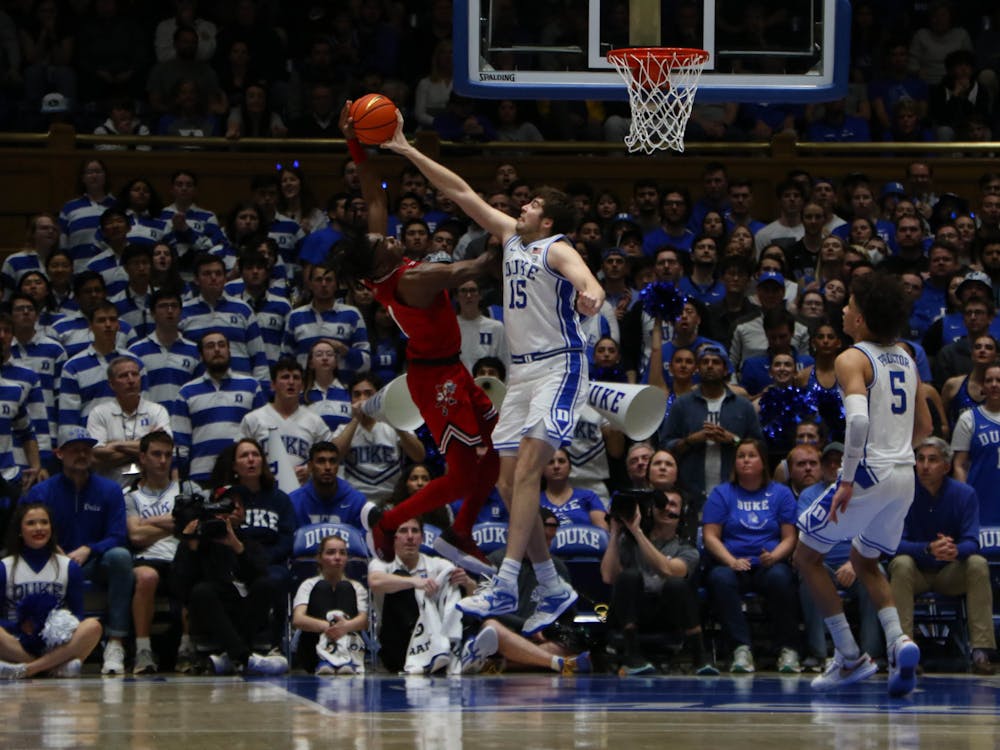Duke men's basketball's rematch with Virginia Tech is inching closer, and the Blue Zone has three keys for the Blue Devils to redeem themselves at home:
Defend the arc
It was unsettling for Blue Devil fans in Cameron Indoor Stadium Monday night to watch Louisville nail three after three, throwing shots from deep way over Duke’s defense. In the first half, the Cardinals knocked down five long-range shots, putting them ahead of the Blue Devils for the first nine minutes. This is not something that can happen Saturday night when Duke takes on Virginia Tech for the penultimate home game of the season. By the end of Monday’s matchup, the box score flashed a bright 41.2% 3-point rate for the Cardinals, largely explaining the Blue Devil deficit that defined the first half of the game.
The Hokies shoot a decent 35.4% from the arc, just a bit better than the Blue Devils’ combined 33.4%. With that, though, Virginia Tech averages eight downtown baskets per game, so a mean 24 points can be expected from three on a given performance. When Duke played it last time, just a few weeks ago, those 24 points turned into 30 — crucial in deciding that Hokie victory. Senior guard Hunter Cattoor played a huge role in building up that stat the last time Duke and Virginia Tech faced off. The Hokies’ 6-foot-3 senior guard knocked down all 15 of his points from behind the arc: He was unstoppable. But this time, in Cameron, the Blue Devils have to stop him. Head coach Jon Scheyer will need to reorient Duke's defense further up-court if he wants to even out the score with Hokie head coach Mike Young.
Anticipate interference
Virginia Tech is a tough team to get around. A month ago, it managed to get in the way of freshman Tyrese Proctor and junior captain Jeremy Roach enough to disrupt Duke's ball movement. Though the Blue Devils did a decent job restricting their number of turnovers — they gave up seven — the Hokies managed to convert their opponents’ fumbles into baskets more than a few times, ultimately earning eight extra points off of Duke’s seven slip-ups.
Where the Blue Devils can certainly dominate the Hokies is in the paint. Virginia Tech’s starting lineup doesn’t have anything near the height in Duke’s top five; their tallest starter, graduate forward Grant Basile, stands at 6-foot-9, a meager height compared to freshmen seven-footers Kyle Filipowski and Dereck Lively II on the Duke end. Sure, the Hokies are scrappy and fast, but even that kind of energy is no match for these Blue Devil bigs when they decide to put up a layup or slam a dunk on the rim.
Share the ball
On Monday night in Cameron Indoor Stadium, freshman forward Mark Mitchell caught a fast break and rushed down the court with the ball. In front of him was Whitehead, standing wide open on the baseline. Mitchell, however, went for the layup — and though fouled, missed.
Duke’s victory over Louisville was yet another testament to the depth of Scheyer’s team. Five players scored in double digits, each starter sharing the wealth to combine for a final score of 79. Clearly, there’s talent all around; the Blue Devils just need to make sure they’re taking advantage of that.
Duke is at its best when cooperation defines the movement on the court. This became clear when it took on then-No. 8 Virginia and found Filipowski out of his usual rhythm, meaning that the rest of the Blue Devils had to step up to compensate. They did relatively well, proving their flexibility even on the road against a major ACC opponent. In most of its games, Duke can afford to rely on a bold performance from a single player, but this tactic fails to take full advantage of the ability and skill on Scheyer’s roster. For the best chance of success Saturday night, the Blue Devils will have to mimic their performance at Virginia, ensuring that the ball is shared between the multitudes of talent on the team.
Get The Chronicle straight to your inbox
Signup for our weekly newsletter. Cancel at any time.

Sophie Levenson is a Trinity junior and a sports managing editor of The Chronicle's 120th volume.

